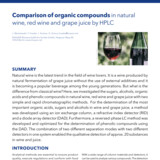
Natural wine is the latest trend in the field of wine lovers. It is a wine produced by natural fermentation of grape juice without the use of external additives and it is becoming a popular beverage among the young generations. But what is the difference from classical wine? Here, we investigated the sugars, alcohols, organic acids and phenolic compounds in natural wine, red wine and grape juice with two simple and rapid chromatographic methods. For the determination of the most important organic acids, sugars and alcohols in wine and grape juice, a method was developed using an ion exchange column, a refractive index detector (RID) and a diode array detector (DAD). Furthermore, a reversed-phase LC method was developed and optimized for the determination of phenolic compounds using the DAD. The combination of two different separation modes with two different detectors in one system enabled the qualitative detection of approx. 20 substances in wine and juice.

Comparison of organic compounds in natural wine, red wine and grape juice by HPLC

Chromatogram of wine 2 measured with Eurokat H, DAD at 210 nm (blue) and RID (red), 60 °C, 0.7 ml/min, 1: tartaric acid, 2: glucose, 3: fructose, 4: succinic acid, 5: glycerol, 6: acetic acid, 7: ethanol.

Signal heights of syringic acid, p-coumaric acid and quercetin in the four different samples.
| Method | HPLC |
|---|---|
| Mode | Ion exclusion, Ligand exchange, RP |
| Substances | Sugars, alcohols, organic acids and phenolic compounds |
| Key words | HPLC, beverage analysis, qualification, RID, DAD, wine, juice, organic compounds |
| CAS number | 57-50-1, 50-99-7, 57-48-7, 56-81-5, 64-17-5, 50-70-4, 87-69-4, 6915-15-7, 138-59-0, 79-33-4, 64-19-7, 77-92-9, 110-15-6, 530-57-4, 121-34-6, 501-98-4, 1135-24-6, 65-85-0, 117-39-5, 520-18-3 |
| Version | Version 1/ 09/2024 |

We are happy to help you